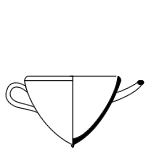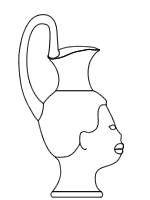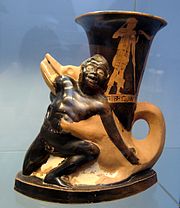Plastic vases
Plastic vases are special vessels, their representation by illustrations in relief are enriched or wholly plastically formed.
Plastic vases, especially in the form of Rhyta, were made in ancient Near East Asia . The production of plastic vessels reached a high point in ancient Greece and in Etruria, which was influenced by Greek art . In addition to rhyta, which were already produced in Minoan and Mycenaean ceramics, askoi and oinochoen appeared early on, and later mastoi , lekytha , thymiateria , drinking horns and kantharoi - especially in the shape of a head - were added. Aryballoi , mainly engaged in Corinth were allowed to flower, and especially in southern Italy produced Guttoi the spectrum enriched plastically shaped vases. Other vessels were shaped like astragaloi , mussels or the like. Plastic vases were mainly made from clay or various metals, rarely from other materials.
| Type | variant | comment | Redrawing | example |
|---|---|---|---|---|
| Figural aryballos |

|
|||
| Plastic askos | Plastic Askoi came in various forms, mostly as animals. |

|
||
| Head mug | ||||
| Figurative guttus |

|
|||
| Head- Kantharos |

|
|||
| Acorn Lekythos |

|
|||
| Mastos |

|

|
||
| Plastic oinochoe | ||||
| Head inochoe |

|

|
||
| Figurative oinochoe | ||||
| Rhyton | one drank from the top |

|

|
|
| Plastic thymiaterion | Open | incense burner |

|
|
| Drinking horn | Greek keras , drinking horn made of metal or clay, often provided with animal protomes at the lower end; one drank from the edge, in contrast to the Rhyton, which drank from the tip |

|
literature
- Wolfgang Schiering : The Greek clay pots. Shape, purpose and change of form (= Gebr.-Mann-Studio-series ). 2nd, significantly changed and expanded edition. Mann, Berlin 1983, ISBN 3-7861-1325-4 , p. 155.
- Stephanie Böhm : Corinthian figure vases. Fragrances, gifts and symbols . Schnell + Steiner, Regensburg 2014, ISBN 978-3-7954-2870-9 .